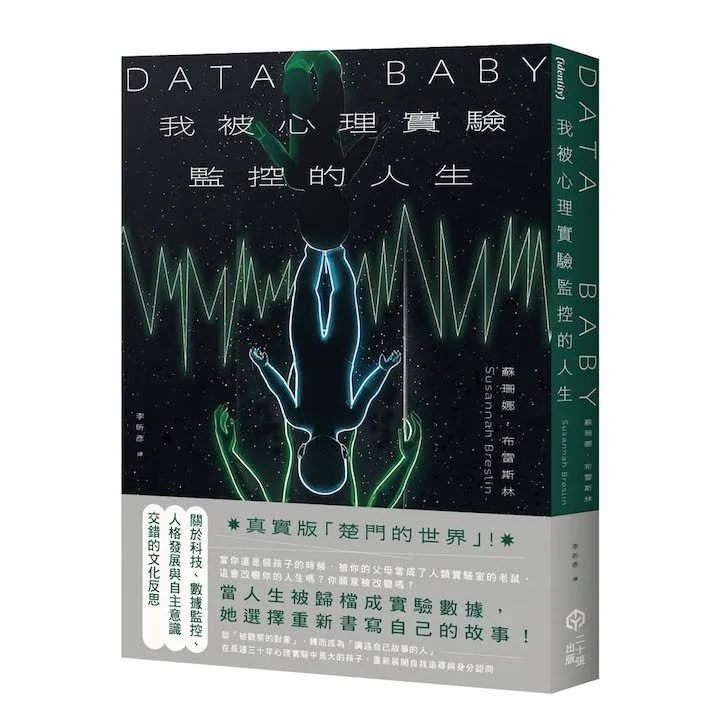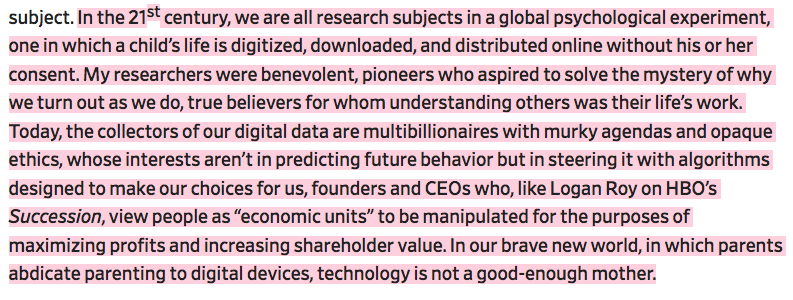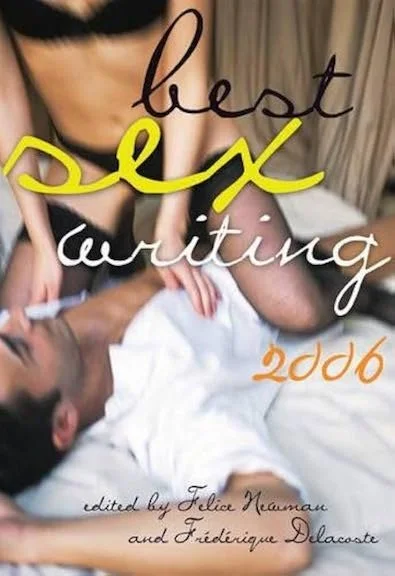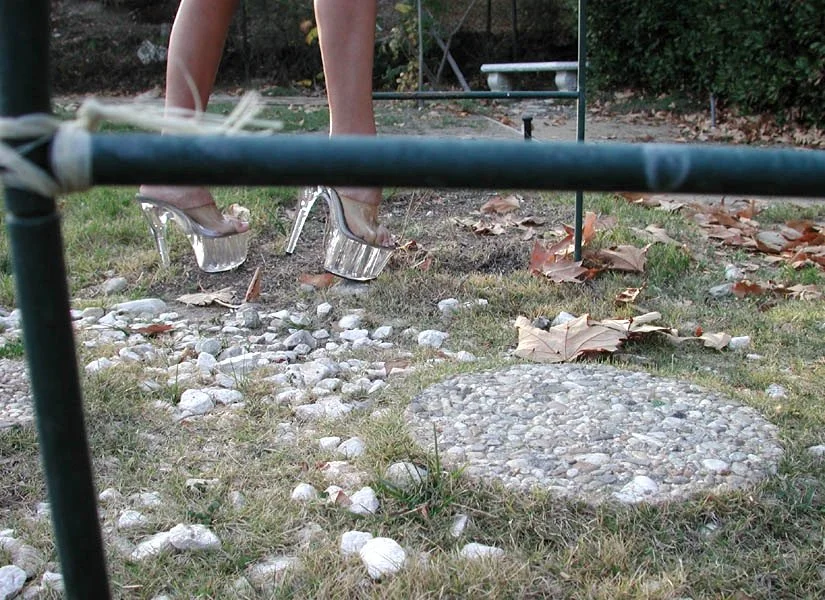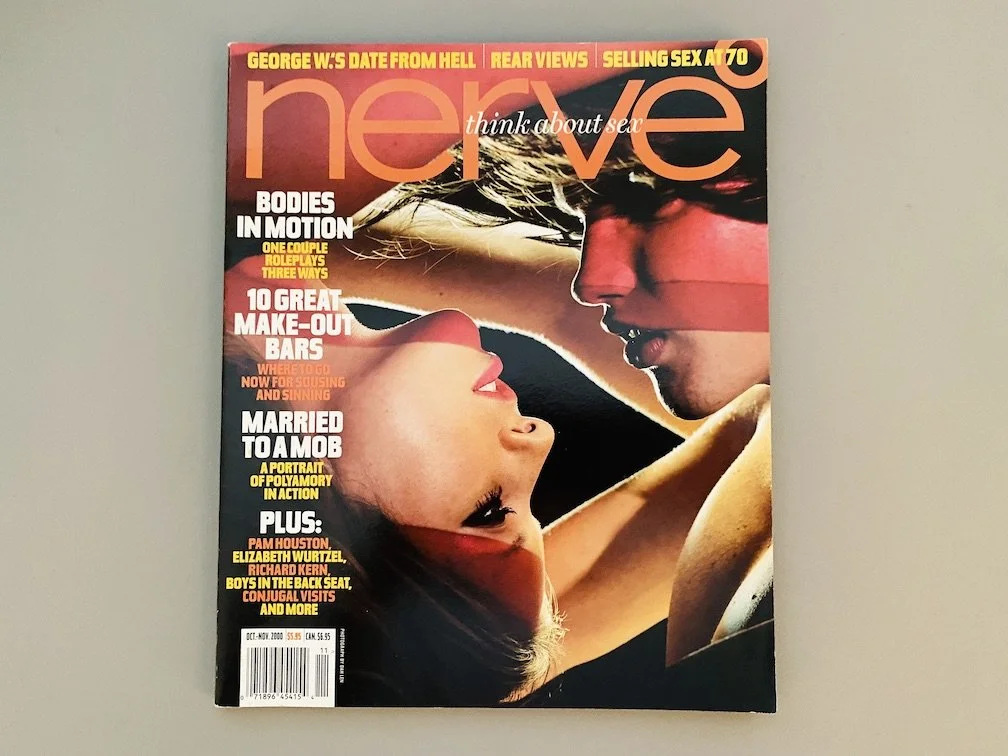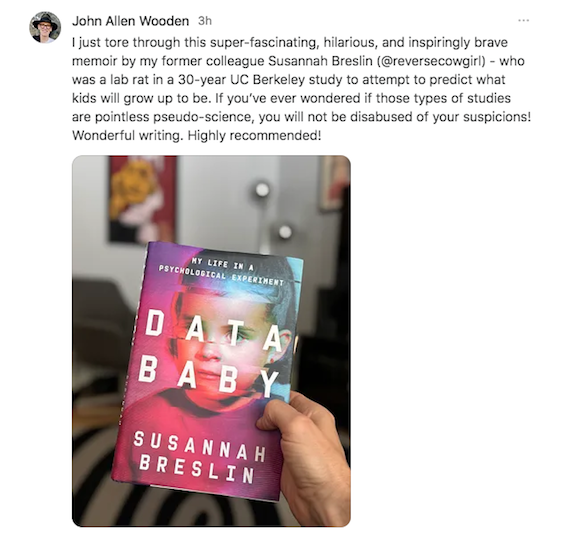Filtering by Tag: NONFICTION
It's Gripping Stuff
“Fascinating. […] Unpacking thorny questions about determinism and the ethics of human experimentation, Breslin attacks her subject with verve and wit, resisting woe-is-me solipsism without defanging her critiques of the study that rocked her life. It’s gripping stuff.” — buy Data Baby: My Life in a Psychological Experiment
About | Consulting I My Book I X I Instagram I LinkedIn I Email
2025 Is Coming Soon
“This spring, I got married to an eraser in the shape of a brain.” That was from 2024. Stay tuned for 2025.
About | Consulting I My Book I X I Instagram I LinkedIn I Email
The Hardest Working Director
“High production value is something of a Greenwood signature. Unlike the low-budget, lo-fi ‘gonzo porn’ of yesteryear, his productions are saturated in deep colors, preoccupied with story, and look more like a movie produced by A24 than garden variety smut.” — How the Hardest Working Director in Porn Gets the Job Done
About | Consulting I My Book I X I Instagram I LinkedIn I Email
Happy 2nd Birthday, Data Baby
Two years ago, I published my memoir, Data Baby: My Life in a Psychological Experiment. In a starred review, Publishers Weekly deemed it “gripping.” Kirkus Reviews called it “An intelligently provocative memoir and investigation.” The Globe and Mail named it “thought-provoking, ridiculously propulsive.” Read about it.
About | Consulting I Email
The Other Uncanny Valley
“‘It’s a phantom-limb penis syndrome,’ said a tall, British man who goes by the name Adam Sutra. Adam is the CEO of CamasutraVR, a company that makes, among other products, virtual-reality pornography. He was trying to explain to me what it’s like when you’re a man, you’re immersed in virtual reality, and you look down at yourself.” — from “Porn’s Uncanny Valley,” The Atlantic, 2018
How Do I Become a Male Porn Star?
“It is unclear if they know who I am. One addressed his email to ‘Sir.’ For the record, I am a woman. I am a journalist. I download their emails in a home office with a desk, a filing cabinet and a garbage can for recycling. I am not who they think I am. I do not have a magic wand that can turn them into male porn stars. I don’t know what to tell them. Truth be told, it is very difficult for men to break into the porn business (unless one rides on the coattails of a female who wants to be a porn star, a scenario with its own set of complications); many of the men who work in porn do not make a lot of money ($150 to $300 for a scene is not uncommon); and what it takes to be a male porn star (to wit: get up, get in, get off) is, for lack of a better word, hard.” — an excerpt from my 2013 Salon personal essay: “How Do I Become a Male Porn Star?”
About I My Book I Newsletter I X I Instagram I LinkedIn I Consulting I Email
Mirror in the Bathroom
“People think The English Beat’s ‘Mirror in the Bathroom’ is about doing cocaine off a mirror, but it’s not.”
About I My Book I Newsletter I X I Instagram I LinkedIn I Consulting I Email
The Real Scene
An excerpt from my 2009 investigation of the Great Recession’s impact on the adult movie industry, “They Shoot Porn Stars, Don’t They?”, a longform piece praised by Longform as “unflinching and devastating.”
About I My Book I Newsletter I X I Instagram I LinkedIn I Consulting I Email
Fuck You, Pay Me #26: My Memoir in Taiwan
This is part 26 of Fuck You, Pay Me, an ongoing series of posts on writing, editing, and publishing.
I’m happy to announce that my memoir, Data Baby: My Life in a Psychological Experiment, has been translated into Mandarin and published in Taiwan by Akker Publishing. I love the haunting and sci-fi-ish new cover.
Data Baby recounts my 30-year tenure, from early childhood and well into adulthood, as a research subject in a pioneering University of California, Berkeley longitudinal study of personality development that sought to predict who a cohort of over 100 Berkeley kids, including me, would grow up to be.
Actress Emma Roberts’ Belletrist book club selected Data Baby as its December 2023 pick. In a starred review, Publishers Weekly called it “a fascinating debut memoir” and “gripping stuff.” Kirkus Reviews deemed it “An intelligently provocative memoir and investigation.” And The Globe and Mail described it as “a thought-provoking, ridiculously propulsive book.” I also wrote an essay about what it’s like to be a child guinea pig for Slate. Learn more about my book here.
About I My Book I Newsletter I X I Instagram I LinkedIn I Consulting I Email
Who's the Lab Rat Now?
Revisiting “I Spent My Childhood as a Guinea Pig for Science. It Was … Great?”—my personal essay, on Slate.
About I My Book I Newsletter I X I Instagram I LinkedIn I Consulting I Email
Anton Chigurh: An Appreciation
For HILOBROW, I wrote a short personal essay about my affection for No Country for Old Men’s Anton Chigurh.
About I My Book I Newsletter I X I Instagram I LinkedIn I Consulting I Email
Post-Traumatic Porn Disorder
“It’s possible, I suppose, I was the first woman to set out to acquire Post-Traumatic Porn Disorder.” Read here.
About I My Book I Newsletter I X I Instagram I LinkedIn I Consulting I Email
A History of America's Most Notorious Business
One of the book projects I’m working on is a nonfiction book about the adult movie industry. The working title is When Pornographers Were Kings: A History of America’s Most Notorious Business. The book interweaves narrative nonfiction, investigative journalism, and reported memoir. While the story’s primary concern is the adult business, from boom to bust to boom again, the narrative also includes my own backstory. In other words, it explores how I came to spend a great deal of time considering the manufacturing of pornography and what the means of production of explicit content and its product say about us as a society and a culture.
Currently, I’m reading Linda Williams’ Hard Core: Power, Pleasure, and the “Frenzy of the Visible”, which I’m embarrassed to confess I’ve never read. (You can read her New York Times obituary here.) Today I ordered Jacques Lacan’s Desire and Its Interpretation, as I haven’t read Lacan since I was in college and feel it will be relevant to some of my ideas about desire and the Other. I’ll probably also re-watch Brian De Palma’s Body Double, which is a marvelous interrogation of seeing and the sexual object and features Melanie Griffith as the adult actress Holly Body.
Probably the most challenging aspect of this book—outside of revisiting Lacan, ha-ha—is bringing to the fore how my background led me to the San Fernando Valley and the indisputably most interesting thing about it. (To quote the late Evan Wright, in his devastating “Scenes From My Life in Porn”: “I would come to joke that the porn video is indigenous Southern California folk art.”) Both my parents were English professors doesn’t exactly suggest one will grow up to write about the porn business. But maybe being raised in a house that was emotionally chilly and in which intimate relationships appeared to be one way but were in fact another might.
One early scene I chose to include near the beginning of my book is something I’d never written about before. I grew up in a two-story pink stucco house on a steep single-block street in the foothills of the Berkeley Hills. My second-floor bedroom was the smallest bedroom. A set of windows faced the street to the east, and a single window faced the neighbor’s house to north. Sometimes at night I would open this side window. Below, there was a small courtyard off our dining room in which tall bamboo grew, and I liked to listen to the rustling the leaves of the bamboo made. In the darkness, I would watch the bamboo list in the wind and crane my neck so I could see the Moon or Orion tracking across the night sky.
At some point, the neighbors moved out, and, as I recall it, someone else moved in. The new neighbors included a man who may have rented the bedroom across the driveway from my room. He seemed to have a lot of girlfriends. Every weekend there was a new woman. There was a ritual to it. The man and this new woman would appear. They would go in the bathroom and reemerge in burgundy bathrobes. They would kiss and then … slip from my view. I had a sense of what they might be doing, but it was vague. I was witnessing a kind of transgression, I surmised.
Revisiting that scene made me wonder if that was a kind of cinematic experience of the erotic. As in a movie theater, I was in a dark room. In the darkness there was an illuminated frame. Within this frame, people upon whom I was spying acted out a drama of intimacy. When I was writing this part of my book, it reminded me of what an adult movie director once said to me about why he had gotten into the porn business. He was a fan of horror movies as a young man, he explained. But what he really wanted to see on the screen was what happened in the pivotal scene when the knife raised, the woman screamed, and the camera cut away. That was porn.
This was originally written for my newsletter. Subscribe to get it every week in your inbox.
About I My Book I Newsletter I X I Instagram I LinkedIn I Consulting I Email
The Young Voyeur
“Revisiting that scene made me wonder if that was a kind of cinematic experience of the erotic.” Read it here.
About I My Book I Newsletter I X I Instagram I LinkedIn I Consulting I Email
When Pornographers Were Kings
One of the books I’m working on at the moment is a book-length work of narrative nonfiction. The title is: When Pornographers Were Kings: A History of America’s Most Notorious Business. More to come soon …
About I My Book I Newsletter I X I Instagram I LinkedIn I Consulting I Email
Jerky Boys
Recently I’ve been tracking down print copies of my older work and posting the stories online. The latest is the October/November issue of Nerve magazine. You may remember Nerve.com. For a spell, they published a print magazine. This short piece focuses on one of the most extreme things I saw in the adult industry.
About I My Book I Newsletter I X I Instagram I LinkedIn I Consulting I Email
Nice Words
Thanks to John Wooden, who gave me my first editing job, for these nice words about my memoir, Data Baby. John has a new newsletter on Substack called EPOSTASY, where he rails against the all consuming “ebyss.”
You should subscribe to it.
About I My Book I Newsletter I X I Instagram I LinkedIn I Consulting I Email
Books I Read: Art Monsters
Art Monsters by Lauren Elkin was my first DNF (did not finish) of the year. I really tried, but I just could not get through this. There’s a certain type of woman writer who seems pathologically afraid of taking a position, determined to privilege the work of others above her own work, and whose lived experienced appears to be largely based on content she’s absorbed through a screen. Riffing polysyllabically on the contradictory nature of art and literature isn’t the same as art criticism; it’s just making noise. This book — as far as I made it — read like a senior thesis that got a book contract. Maybe it gets better. I’ll never know.
About I Book I Newsletter I X I Instagram I LinkedIn I Consulting I Email
The Gigolo
Gigolos star Nick Hawk, Las Vegas, Nev., 2013 | Image credit: Susannah Breslin
In the process of researching something I started writing for my newsletter but didn’t publish, I came across this 2013 post from Forbes.com that I wrote when was on a “XXX safari” in Las Vegas, Nevada, at the porn Oscars.
*
I learned a few things about journalism doing my series on the porn blitz in Vegas this month, and here they are, in no particular order.
TIP #1: Get the right tools
For the last few years, I've been carrying around those composition books to take notes. That's got to stop. They're too big. If I've got too much stuff going on, I've been known to stick the composition book in the back of my pants. Not my back pocket. Between my back and the inside of my waistband. Not a good look. I need smaller notebooks so I can put them in the pockets of these pants I've been wearing as my "journalist pants" that look like I'm on a safari, only in this case it was like a XXX safari.
I also need to start using the neck strap for my camera. I spent my time in Vegas pulling my camera in and out of my bag. I should probably get over my fear of the neck strap breaking and killing my camera.
Speaking of cameras, I need a new one. Related: If anyone found my lens cap in Vegas, let me know.
I also need a proper bag. I used a bag I think I bought at Payless. It was for shopping at the mall. Not writing stories.
TIP #2: Figure out what you can handle
Before I got to Vegas, I thought I would maybe go back and forth between the convention and the media room and post LIVE FROM THE FRONTLINES. That didn't happen; although, I did walk around that entire first day with my laptop in my bag. Not only did I not post LIVE FROM THE FRONTLINES, I realized that I'm too slow for that. Or in this case I was, at least.
The other big thing was that I was adding taking photographs into the mix. I think I did this because I've been a journalist for 15 years, and I am looking for a new challenge.
At this point, I don't really have any big hangups as a journalist. For example, at one point, I was at the convention, and I was looking for this gigolo. I'd seen him on a panel. He sat at the front of the room with another guy, and the theme of the panel was, "A bunch of people have crossed over from adult to mainstream, but what about people who have crossed over from mainstream to adult?" These guys were supposed to be examples of that. The gigolo is the star of a Showtime show called "Gigolos," and the other guy was a rock star who ended up on "Sex Rehab with Dr. Drew" and then made a celebrity sex tape because "that's what you do."
Anyway, the gigolo's name is Nick Hawk. (That's him in the photo at the top of this post.) He has an entire line of adult products. When Nick was on the panel, he had a bunch of boxes sitting next to him with his products in them, and at one point he said of creating a product that is a reproduction of a part of him, "That was one of the biggest excitements of my life."
After that, I kept looking for Nick, but I couldn't find him. I was standing against a wall because my back was killing me from all the stuff that I didn't need that I was carrying, and then I looked to my left, and there was Nick Hawk, and he was about to walk into the men's room, which was apparently what I was standing right next to.
"HEY," I yelled at Nick, without thinking. For some reason, this was the highlight of my experience as a journalist in Vegas. That I am a person who is willing to shout at a gigolo going into the toilet in order to get an interview. There is no shame in my game. Not at this point.
I hope all young women journalists can learn from my model. That you should always yell at men you want to interview, regardless of their occupation or proximity to the lavatory, because if you don't, you might not get an interview with them, and then you'll be the journalist who went there and got nothing. Which isn't a journalist at all. That's just something else.
"I'm proud to be a gigolo," Nick told me after he came out of the bathroom. "I'm not sure I'd be proud to be a porn star."
TIP #3: Seek help from people who know what they are doing
I really liked going to Vegas because it reminded me who I really am. The hardest part was the taking photographs because my knowledge of photography is limited. Which is an understatement. So the photography stuff I did was time consuming, and sometimes it didn't come out right because I didn't know what I was doing.
When I got home, I made an appointment to hang out with a guy who's a photographer. We sat in a cafe, and he told me how cameras work, and we looked at some of my photos from Vegas that were still on my camera, and we talked about what was right about them and what was wrong about them.
Then we wandered around outside and took some photos. It was cold. The stuff I photographed outside was pretty boring. The stuff in Vegas was way more interesting.
The task he left me with is to do more things like Vegas. And get better. And I think if I can do those things, I'll figure out more who I want to be or whatever I'm becoming.
About I Book I Newsletter I X I Instagram I LinkedIn I Consulting I Email








